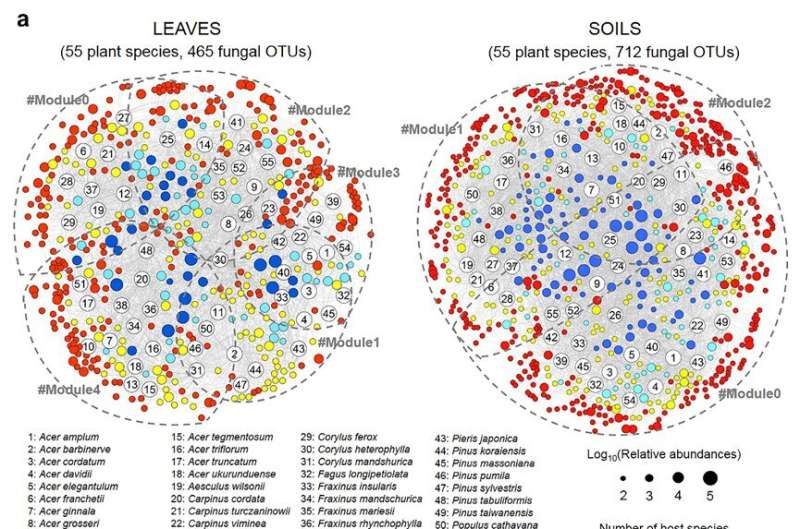How tree species link fungal partners across a large-scale forest ecosystem

In a study published in Science China Life Sciences, a team surveyed hyper-diverse fungal communities in approximately 500 paired leaf and soil samples, which were associated with 55 tree species that are located over 2,000-km span of mountain forests in eastern China.
"It wasn't an easy job. We spent the whole two years completing the field sampling. Climbing mountains, searching for trees, collecting soils and leaves, and so on," says Yang, first author of the study.
At the beginning, Yang, together with lab director Haiyan Chu, sought to compare the fungal biogeographic patterns in leaves and soils. Previously, in The ISME Journal, they reported a significant phylogenetic imprint of trees on the soil fungal community composition in the same region, highlighting an evolutionary linkage between plant species and associated fungal communities belowground.
However, when involving diverse plant species and large spatial scales, how the biogeographic pattern of fungal community in leaves differs from that observed in soils was still unknown.
In their latest paper, they found striking differences in fungal richness and community composition between leaves and soils; the soil fungal species number was about three times higher than that of foliar fungal community at the tree individual level. Plant species identity and plant phylogeny drove the distribution of foliar fungal community, whereas the distribution of soil fungi was attributed to the interactive effects of plant phylogeny, climatic factors and soil properties.
"Undoubtedly, soil fungal community beneath trees is more complicated and affected by the multiple environmental factors, whereas fungal community in leaves seems to be merely determined by plant host availability," Chu says.
Cross-kingdom biotic interactions, for example, between plants and their animal pollinators or seed dispersers, are an attractive theme in ecological and biogeographic research fields and led to the development of early bipartite network theory. Specialization, modularity, and robustness are the critical network topological characteristics.
For example, specialization describes the degree to which a host plant or fungal partner is restricted in its range of partners or hosts; modularity describes the extent to which the network is structured as different cohesive subgroups of nodes (i.e., modules), in which the density of interactions is higher within modules than among modules.
Additionally, robustness represents the capability of a network to maintain its structure and organization when suffering from perturbance. Using the bipartite network theory, the team reveals the incongruent plant-fungus network topologies in aboveground and belowground habitats.
The plant-fungus networks in leaves exhibited significantly higher specialization, modularity and robustness, but less connected than those in soils. In addition, tree/fungus preference combinations and key species in bipartite networks differed strikingly between aboveground and belowground samples.
"At broad spatial scales, this work demonstrates the different plant-fungus assembly patterns between aboveground and belowground habitats from the aspects of biogeographic driving forces, bipartite network characteristics and network key species. Perhaps most excitingly, the findings alert us that community shifts of trees due to climate change or human activities will impair aboveground and belowground forest fungal diversity in quite different ways," Chu says.
The study is published in the journal Science China Life Sciences.
More information: Teng Yang et al, Plant and fungal species interactions differ between aboveground and belowground habitats in mountain forests of eastern China, Science China Life Sciences (2022). DOI: 10.1007/s11427-022-2174-3
Teng Yang et al, Phylogenetic imprint of woody plants on the soil mycobiome in natural mountain forests of eastern China, The ISME Journal (2018). DOI: 10.1038/s41396-018-0303-x
Journal information: Science China Life Sciences , ISME Journal
Provided by Science China Press





















